Minute-Cadence Observations of the LAMOST Fields with the TMTS: IV—Catalog of Cataclysmic Variables from the First 3-yr Survey
Abstract
1. Introduction
2. Observations and Data Analysis
2.1. TMTS CV Sample
2.2. Light-Curve Analysis
2.2.1. Periodic Variations
2.2.2. Light-Curve Features
- Eclipse. Thanks to densely sampled photometry, the TMTS light curves allow us to characterize the detailed profiles of eclipses for the eclipsing CVs. In our CV samples, the eclipse depth ranges from a few tenths of magnitude to more than 2.0 mag. The emergence of an eclipse provides direct evidence supporting the notion that the CV system has an orbital inclination approaching .
- Low-amplitude periodic variation. With the amplitude distribution of noneclipse CV systems (see Figure 1), 20 CV samples presented periodic modulation amplitude of about 0.1–0.4 mag, while 2 CV samples exhibited a significantly higher modulation amplitude. Low-amplitude periodic variations here are defined as periodic variations with an amplitude lower than 0.4 mag, which are typically caused by the hump/superhump of CVs and are thus tightly related to their orbital periods.
- High-amplitude periodic variation. In contrast, high-amplitude periodic variations represent modulations with an abnormally high amplitude. Here, we roughly define them as periodic variations with an amplitude larger than 0.4 mag.
- Rapid periodic variation. Since the quasi-periodic oscillations of DNe and rotation modulations of IPs are difficult to distinguish with the single-night light curves, here, the rapid periodic variations represent all periodic or quasi-periodic variations below 20 min, significantly shorter than the periodic variations induced via orbital modulations.
2.3. Spectroscopic Analysis
3. Individual Systems
3.1. Newly Discovered CVs and CV Candidates
3.1.1. TMTS J04405040+6820355
3.1.2. TMTS J06183036+5105550
3.2. New Light-Variation Features from Known CVs
3.2.1. SDSS J013855.86+242939.2
3.2.2. TMTS J03471387+1611083
3.2.3. FO Per
3.2.4. SS Aur
3.2.5. V378 Peg
3.2.6. Possible QPOs
4. Discussion
4.1. Statistical Properties of EW and FWHM for Nonmagnetic CVs
4.2. The Implications of TMTS Light Curves
5. Conclusions
Author Contributions
Funding
Data Availability Statement
Acknowledgments
Conflicts of Interest
Appendix A
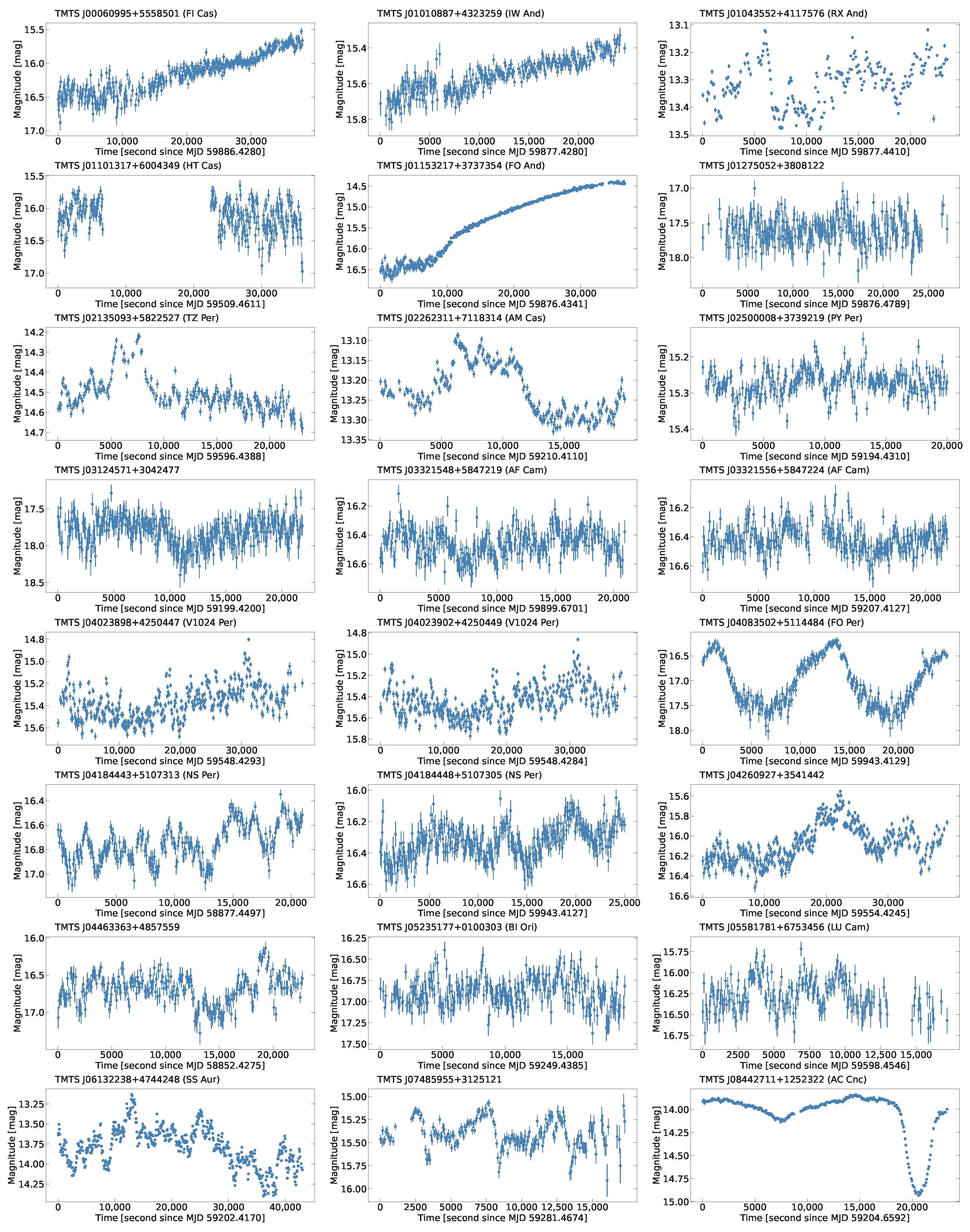
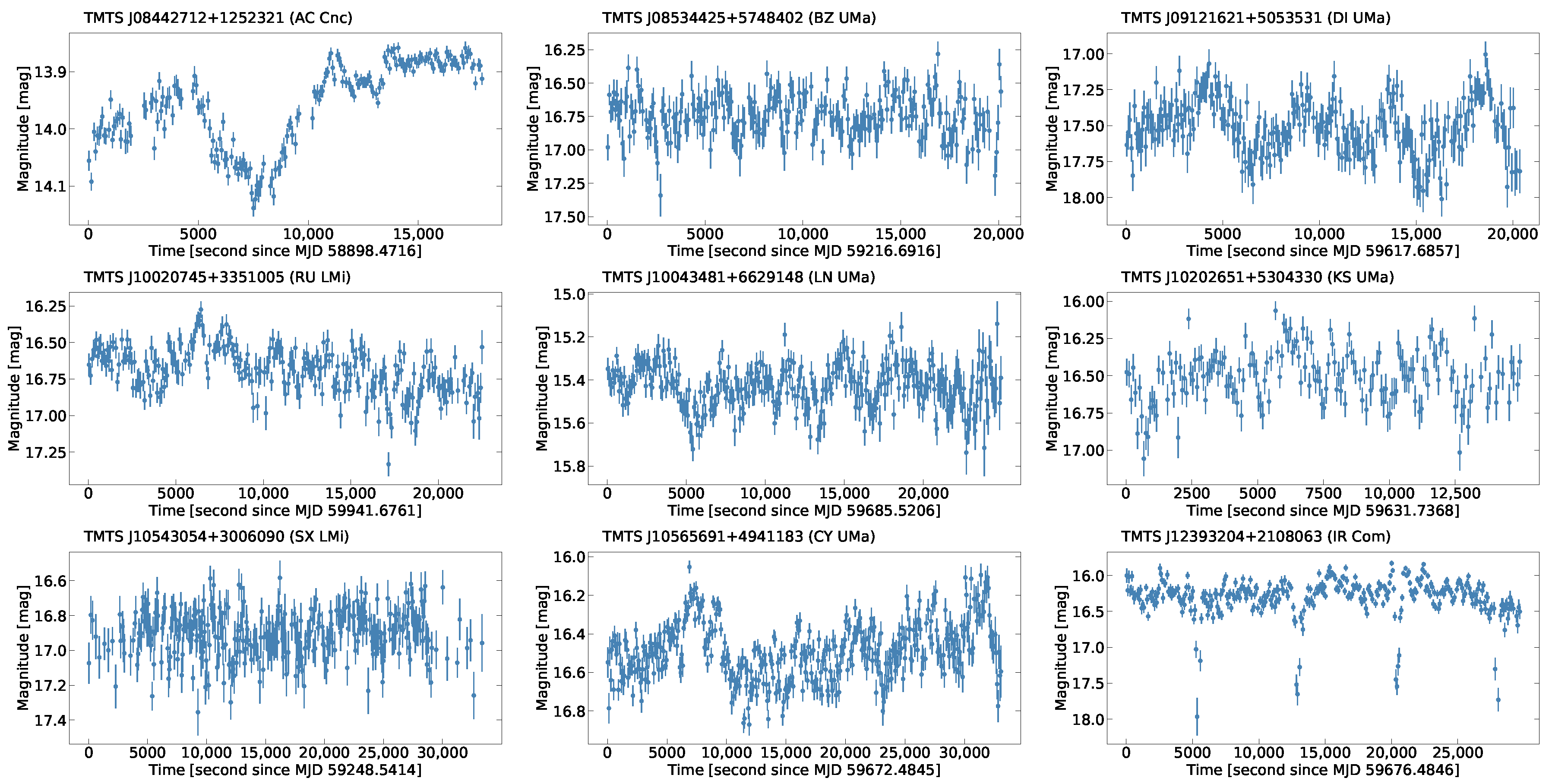

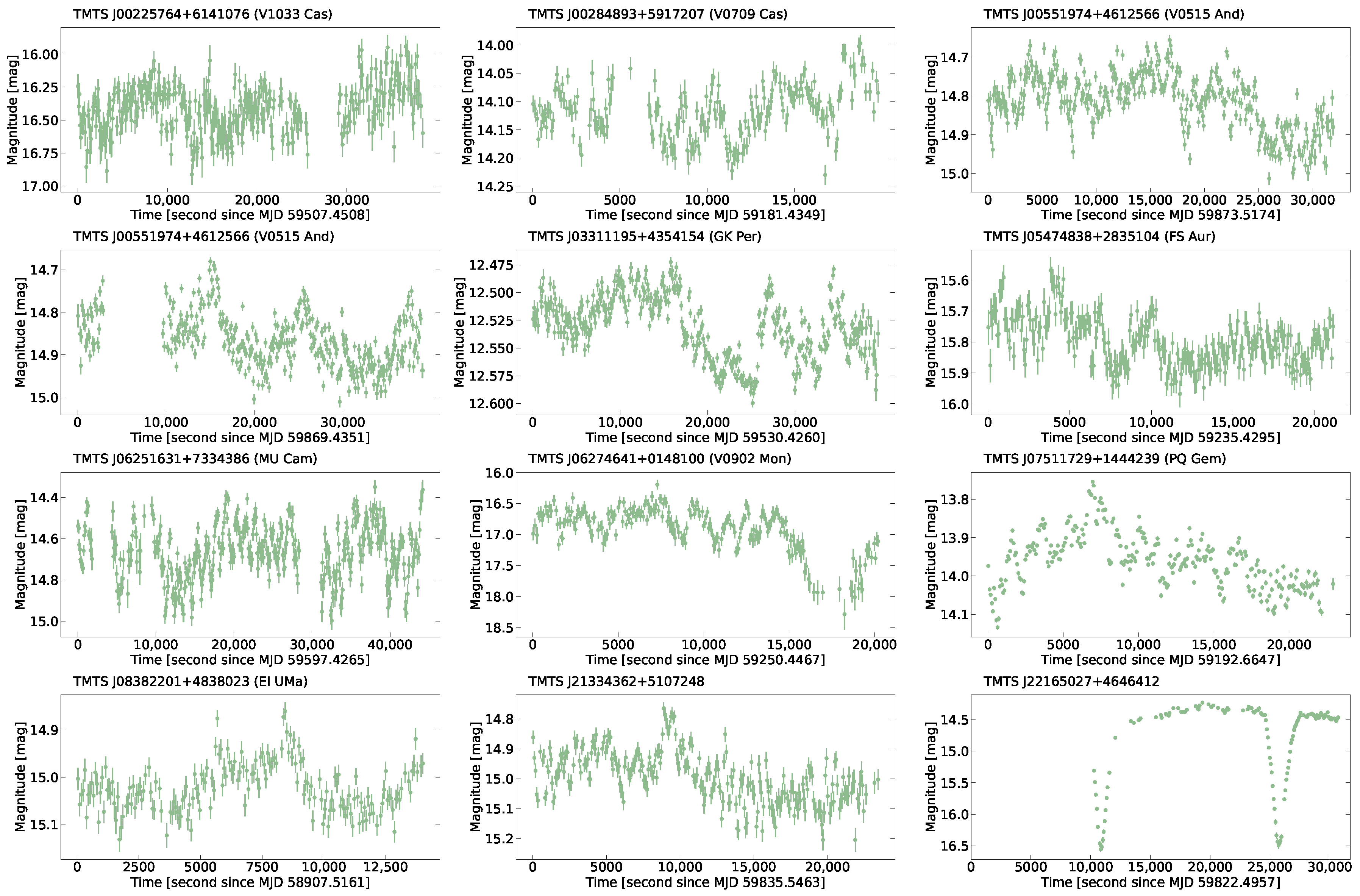
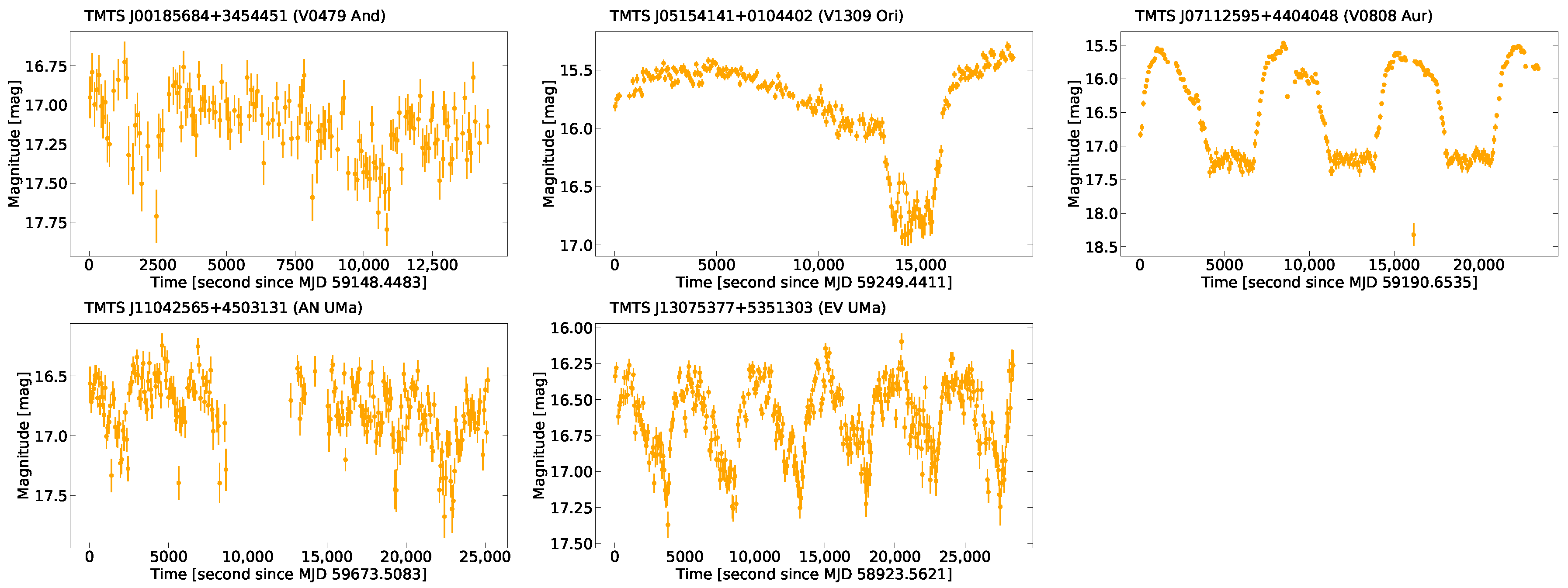

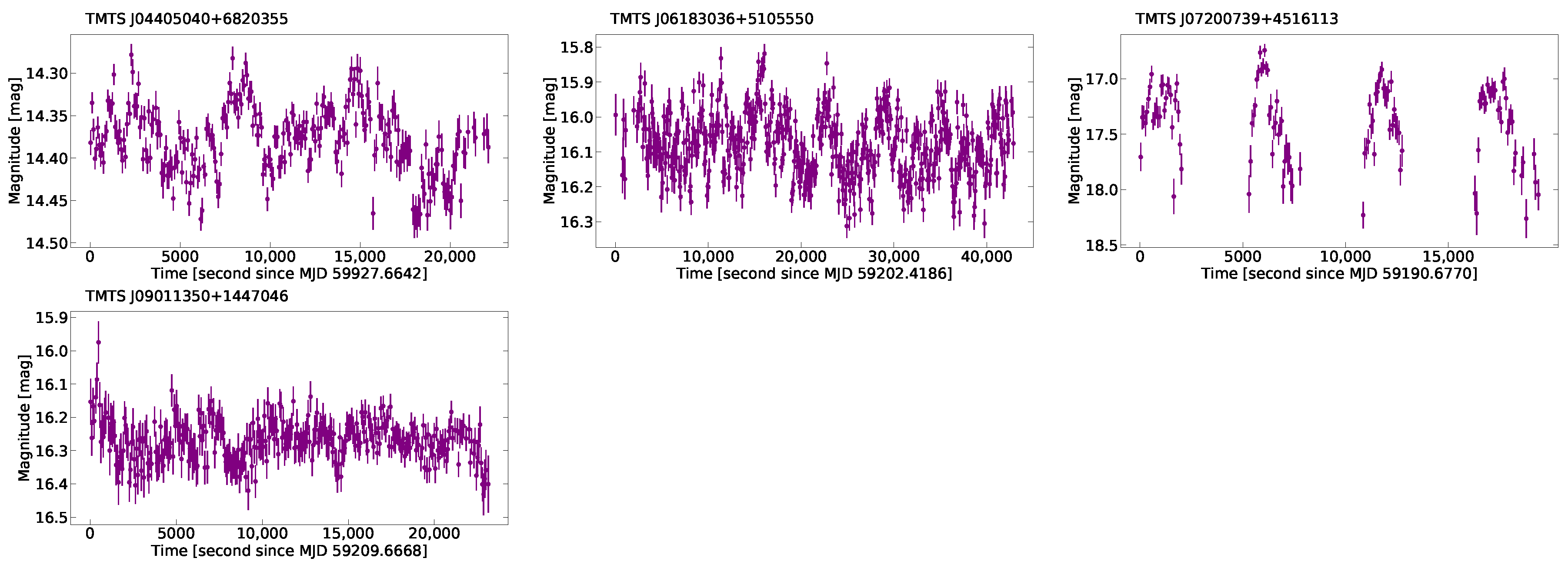


References
- Maoz, D.; Mannucci, F.; Nelemans, G. Observational Clues to the Progenitors of Type Ia Supernovae. Annu. Rev. Astron. Astrophys. 2014, 52, 107–170. [Google Scholar] [CrossRef]
- Liu, Z.W.; Röpke, F.K.; Han, Z. Type Ia Supernova Explosions in Binary Systems: A Review. Res. Astron. Astrophys. 2023, 23, 082001. [Google Scholar] [CrossRef]
- Nelemans, G.; Portegies Zwart, S.F.; Verbunt, F.; Yungelson, L.R. Population synthesis for double white dwarfs. II. Semi-detached systems: AM CVn stars. Astron. Astrophys. 2001, 368, 939–949. [Google Scholar] [CrossRef]
- Podsiadlowski, P.; Han, Z.; Rappaport, S. Cataclysmic variables with evolved secondaries and the progenitors of AM CVn stars. Mon. Not. R. Astron. Soc. 2003, 340, 1214–1228. [Google Scholar] [CrossRef]
- Luo, J.; Chen, L.S.; Duan, H.Z.; Gong, Y.G.; Hu, S.; Ji, J.; Liu, Q.; Mei, J.; Milyukov, V.; Sazhin, M.; et al. TianQin: A space-borne gravitational wave detector. Class. Quantum Gravity 2016, 33, 035010. [Google Scholar] [CrossRef]
- Amaro-Seoane, P.; Audley, H.; Babak, S.; Baker, J.; Barausse, E.; Bender, P.; Berti, E.; Binetruy, P.; Born, M.; Bortoluzzi, D.; et al. Laser Interferometer Space Antenna. arXiv 2017, arXiv:1702.00786. [Google Scholar] [CrossRef]
- Warner, B. Cataclysmic Variable Stars; Cambridge Astrophysics Series; Cambridge University Press: Cambridge, UK, 1995; Volume 28. [Google Scholar]
- Khangale, Z.N.; Woudt, P.A.; Potter, S.B.; Warner, B.; Kilkenny, D.; van der Heyden, K. A spectroscopic analysis of the eclipsing nova-like EC 21178-5417—Discovery of spiral density structures. Mon. Not. R. Astron. Soc. 2020, 495, 637–649. [Google Scholar] [CrossRef]
- Bridge, C.M.; Hakala, P.; Cropper, M.; Ramsay, G. Accretion stream mapping with ‘genetically modified fireflies’. Mon. Not. R. Astron. Soc. 2004, 351, 1423–1429. [Google Scholar] [CrossRef]
- Kennedy, M.R.; Garnavich, P.M.; Littlefield, C.; Marsh, T.R.; Callanan, P.; Breton, R.P.; Augusteijn, T.; Wagner, R.M.; Ashley, R.P.; Neric, M. Optical spectra of FO Aquarii during low and high accretion rates. Mon. Not. R. Astron. Soc. 2020, 495, 4445–4462. [Google Scholar] [CrossRef]
- Wu, K. Accretion onto Magnetic White Dwarfs. Space Sci. Rev. 2000, 93, 611–649. [Google Scholar] [CrossRef]
- Busschaert, C.; Falize, É.; Michaut, C.; Bonnet-Bidaud, J.M.; Mouchet, M. Quasi-periodic oscillations in accreting magnetic white dwarfs. II. The asset of numerical modelling for interpreting observations. Astron. Astrophys. 2015, 579, A25. [Google Scholar] [CrossRef]
- Bruch, A. TESS light curves of cataclysmic variables—II—Superhumps in old novae and novalike variables. Mon. Not. R. Astron. Soc. 2023, 519, 352–376. [Google Scholar] [CrossRef]
- Osaki, Y. Dwarf-Nova Outbursts. Publ. Astron. Soc. Pac. 1996, 108, 39. [Google Scholar] [CrossRef]
- Whitehurst, R.; King, A. Superhumps, resonances and accretion discs. Mon. Not. R. Astron. Soc. 1991, 249, 25–35. [Google Scholar] [CrossRef]
- Wood, M.A.; Thomas, D.M.; Simpson, J.C. SPH simulations of negative (nodal) superhumps: A parametric study. Mon. Not. R. Astron. Soc. 2009, 398, 2110–2121. [Google Scholar] [CrossRef]
- Thomas, D.M.; Wood, M.A. The Emergence of Negative Superhumps in Cataclysmic Variables: Smoothed Particle Hydrodynamics Simulations. Astrophys. J. 2015, 803, 55. [Google Scholar] [CrossRef]
- Knigge, C. The donor stars of cataclysmic variables. Mon. Not. R. Astron. Soc. 2006, 373, 484–502. [Google Scholar] [CrossRef]
- Spruit, H.C.; Ritter, H. Stellar activity and the period gap in cataclysmic variables. Astron. Astrophys. 1983, 124, 267–272. [Google Scholar]
- Patterson, J. The evolution of cataclysmic and low-mass X-ray binaries. Astrophys. J. Suppl. Ser. 1984, 54, 443–493. [Google Scholar] [CrossRef]
- Williams, R.E. Emission lines from the accretion disks of cataclysmic variables. Astrophys. J. 1980, 235, 939–944. [Google Scholar] [CrossRef]
- Cheng, F.H.; Lin, D.N.C. Spectral Evolution of Accretion Disks of Dwarf Novae. II. Radiative Transfer Models. Astrophys. J. 1989, 337, 432. [Google Scholar] [CrossRef]
- Sarty, G.E.; Wu, K. Multivariate Characterization of Hydrogen Balmer Emission in Cataclysmic Variables. Publ. Astron. Soc. Aust. 2006, 23, 106–118. [Google Scholar] [CrossRef]
- Koch, D.G.; Borucki, W.J.; Basri, G.; Batalha, N.M.; Brown, T.M.; Caldwell, D.; Christensen-Dalsgaard, J.; Cochran, W.D.; DeVore, E.; Dunham, E.W.; et al. Kepler Mission Design, Realized Photometric Performance, and Early Science. Astrophys. J. Lett. 2010, 713, L79–L86. [Google Scholar] [CrossRef]
- Ricker, G.R.; Winn, J.N.; Vanderspek, R.; Latham, D.W.; Bakos, G.Á.; Bean, J.L.; Berta-Thompson, Z.K.; Brown, T.M.; Buchhave, L.; Butler, N.R.; et al. Transiting Exoplanet Survey Satellite (TESS). J. Astron. Telesc. Instrum. Syst. 2015, 1, 014003. [Google Scholar] [CrossRef]
- Otulakowska-Hypka, M.; Olech, A.; Patterson, J. Statistical analysis of properties of dwarf novae outbursts. Mon. Not. R. Astron. Soc. 2016, 460, 2526–2541. [Google Scholar] [CrossRef]
- Bruch, A. Flickering around the outburst cycle in Kepler dwarf novae. Mon. Not. R. Astron. Soc. 2022, 509, 4669–4678. [Google Scholar] [CrossRef]
- Zhang, J.C.; Wang, X.F.; Mo, J.; Xi, G.B.; Lin, J.; Jiang, X.J.; Zhang, X.M.; Li, W.X.; Yan, S.Y.; Chen, Z.H.; et al. The Tsinghua University-Ma Huateng Telescopes for Survey: Overview and Performance of the System. Publ. Astron. Soc. Pac. 2020, 132, 125001. [Google Scholar] [CrossRef]
- Cui, X.Q.; Zhao, Y.H.; Chu, Y.Q.; Li, G.P.; Li, Q.; Zhang, L.P.; Su, H.J.; Yao, Z.Q.; Wang, Y.N.; Xing, X.Z.; et al. The Large Sky Area Multi-Object Fiber Spectroscopic Telescope (LAMOST). Res. Astron. Astrophys. 2012, 12, 1197–1242. [Google Scholar] [CrossRef]
- Zhao, G.; Zhao, Y.H.; Chu, Y.Q.; Jing, Y.P.; Deng, L.C. LAMOST spectral survey—An overview. Res. Astron. Astrophys. 2012, 12, 723–734. [Google Scholar] [CrossRef]
- Lin, J.; Wang, X.; Mo, J.; Xi, G.; Zhang, J.; Jiang, X.; Shi, J.; Zhang, X.; Zhang, X.; Wei, Z.; et al. Minute-cadence observations of the LAMOST fields with the TMTS: I. Methodology of detecting short-period variables and results from the first-year survey. Mon. Not. R. Astron. Soc. 2022, 509, 2362–2376. [Google Scholar] [CrossRef]
- Liu, Q.; Lin, J.; Wang, X.; Gu, S.; Shi, J.; Zhang, L.; Xi, G.; Mo, J.; Cai, Y.; Chen, L.; et al. Minute-cadence observations of the LAMOST fields with the TMTS—III. Statistical study of the flare stars from the first two years. Mon. Not. R. Astron. Soc. 2023, 523, 2193–2208. [Google Scholar] [CrossRef]
- Lin, J.; Wu, C.; Xiong, H.; Wang, X.; Németh, P.; Han, Z.; Li, J.; Elias-Rosa, N.; Salmaso, I.; Filippenko, A.V.; et al. A seven-Earth-radius helium-burning star inside a 20.5-min detached binary. Nat. Astron. 2024, 8, 491–503. [Google Scholar] [CrossRef]
- Lin, J.; Wu, C.; Wang, X.; Németh, P.; Xiong, H.; Wu, T.; Filippenko, A.V.; Cai, Y.; Brink, T.G.; Yan, S.; et al. An 18.9 min blue large-amplitude pulsator crossing the ‘Hertzsprung gap’ of hot subdwarfs. Nat. Astron. 2023, 7, 223–233. [Google Scholar] [CrossRef]
- Lin, J.; Wang, X.; Mo, J.; Xi, G.; Filippenko, A.V.; Yan, S.; Brink, T.G.; Yang, Y.; Wu, C.; Németh, P.; et al. Minute-cadence observations of the LAMOST fields with the TMTS: II. Catalogues of short-period variable stars from the first 2-yr surveys. Mon. Not. R. Astron. Soc. 2023, 523, 2172–2192. [Google Scholar] [CrossRef]
- Guo, F.; Lin, J.; Wang, X.; Chen, X.; Li, T.; Chen, L.; Xia, Q.; Mo, J.; Xi, G.; Zhang, J.; et al. Minute-cadence observations of the LAMOST Fields with the TMTS—V. Machine learning classification of TMTS catalogues of periodic variable stars. Mon. Not. R. Astron. Soc. 2024, 528, 6997–7015. [Google Scholar] [CrossRef]
- Wenger, M.; Ochsenbein, F.; Egret, D.; Dubois, P.; Bonnarel, F.; Borde, S.; Genova, F.; Jasniewicz, G.; Laloë, S.; Lesteven, S.; et al. The SIMBAD astronomical database. The CDS reference database for astronomical objects. Astron. Astrophys. Suppl. 2000, 143, 9–22. [Google Scholar] [CrossRef]
- Downes, R.A.; Webbink, R.F.; Shara, M.M.; Ritter, H.; Kolb, U.; Duerbeck, H.W. A Catalog and Atlas of Cataclysmic Variables: The Living Edition. Publ. Astron. Soc. Pac. 2001, 113, 764–768. [Google Scholar] [CrossRef]
- Ritter, H.; Kolb, U. Catalogue of cataclysmic binaries, low-mass X-ray binaries and related objects (Seventh edition). Astron. Astrophys. 2003, 404, 301–303. [Google Scholar] [CrossRef]
- Szkody, P.; Anderson, S.F.; Brooks, K.; Gänsicke, B.T.; Kronberg, M.; Riecken, T.; Ross, N.P.; Schmidt, G.D.; Schneider, D.P.; Agüeros, M.A.; et al. Cataclysmic Variables from the Sloan Digital Sky Survey. VIII. The Final Year (2007–2008). Astron. J. 2011, 142, 181. [Google Scholar] [CrossRef]
- Sun, Y.; Cheng, Z.; Ye, S.; Ding, R.; Peng, Y.; Zhang, J.; Huo, Z.; Cui, W.; Wang, X.; Shi, J.; et al. A Catalog of 323 Cataclysmic Variables from LAMOST DR6. Astrophys. J. Suppl. Ser. 2021, 257, 65. [Google Scholar] [CrossRef]
- Watson, C.L.; Henden, A.A.; Price, A. The International Variable Star Index (VSX). Soc. Astron. Sci. Annu. Symp. 2006, 25, 47. [Google Scholar]
- Hou, W.; Luo, A.l.; Li, Y.B.; Qin, L. Spectroscopically Identified Cataclysmic Variables from the LAMOST Survey. I. The Sample. Astron. J. 2020, 159, 43. [Google Scholar] [CrossRef]
- Thorstensen, J.R. Follow-up Studies of Five Cataclysmic Variable Candidates Discovered by LAMOST. Astron. J. 2020, 160, 151. [Google Scholar] [CrossRef]
- Szkody, P.; Anderson, S.F.; Hayden, M.; Kronberg, M.; McGurk, R.; Riecken, T.; Schmidt, G.D.; West, A.A.; Gänsicke, B.T.; Nebot Gomez-Moran, A.; et al. Cataclysmic Variables from SDSS. VII. The Seventh Year (2006). Astron. J. 2009, 137, 4011–4019. [Google Scholar] [CrossRef]
- Denisenko, D. MASTER OT J072007.30+451611.6: Cataclysmic Variable with an Extreme Hot Spot. Astron. Telegr. 2018, 11626, 1. [Google Scholar]
- Drake, A.J.; Graham, M.J.; Djorgovski, S.G.; Catelan, M.; Mahabal, A.A.; Torrealba, G.; García-Álvarez, D.; Donalek, C.; Prieto, J.L.; Williams, R.; et al. The Catalina Surveys Periodic Variable Star Catalog. Astrophys. J. Suppl. Ser. 2014, 213, 9. [Google Scholar] [CrossRef]
- Osborne, J.P.; Page, K.L.; Henden, A.A.; Ness, J.-U.; Bode, M.F.; Schwarz, G.J.; Starrfield, S.; Drake, J.J.; Kuulkers, E.; Beardmore, A.P. Swift observations of the March 2011 outburst of the cataclysmic variable NSV 1436: A probable dwarf nova. Astron. Astrophys. 2011, 533, A41. [Google Scholar] [CrossRef]
- Denisenko, D.; Podvorotny, P.; Balanutsa, P.; Shurpakov, S.; Tiurina, N.; Gorbovskoy, E.; Lipunov, V.; Kornilov, V.; Belinski, A.; Shatskiy, N.; et al. One very bright and one bright OT detected by MASTER. Astron. Telegr. 2012, 4441, 1. [Google Scholar]
- Kato, T.; Hambsch, F.J.; Monard, B.; Vanmunster, T.; Maeda, Y.; Miller, I.; Itoh, H.; Kiyota, S.; Isogai, K.; Kimura, M.; et al. Survey of period variations of superhumps in SU UMa-type dwarf novae. VIII. The eighth year (2015–2016). Publ. Astron. Soc. Jpn. 2016, 68, 65. [Google Scholar] [CrossRef]
- Kozhevnikov, V.P. An extensive photometric study of the recently discovered intermediate polar V515 And (XSS J00564+4548). Mon. Not. R. Astron. Soc. 2012, 422, 1518–1526. [Google Scholar] [CrossRef][Green Version]
- Witham, A.R.; Knigge, C.; Aungwerojwit, A.; Drew, J.E.; Gänsicke, B.T.; Greimel, R.; Groot, P.J.; Roelofs, G.H.A.; Steeghs, D.; Woudt, P.A. Newly discovered cataclysmic variables from the INT/WFC photometric Hα survey of the northern Galactic plane. Mon. Not. R. Astron. Soc. 2007, 382, 1158–1168. [Google Scholar] [CrossRef]
- Yakin, D.G.; Suleimanov, V.F.; Vlasyuk, V.V.; Spiridonova, O.I. HBHA 4705-03: A new cataclysmic variable. Astron. Lett. 2013, 39, 38–53. [Google Scholar] [CrossRef]
- Thorne, K.; Garnavich, P.; Mohrig, K. The Polar CSS 081231:071126+440405 at a Low Accretion Rate. Inf. Bull. Var. Stars 2010, 5923, 1. [Google Scholar] [CrossRef]
- Lomb, N.R. Least-Squares Frequency Analysis of Unequally Spaced Data. Astrophys. Space Sci. 1976, 39, 447–462. [Google Scholar] [CrossRef]
- Scargle, J.D. Studies in astronomical time series analysis. II. Statistical aspects of spectral analysis of unevenly spaced data. Astrophys. J. 1982, 263, 835–853. [Google Scholar] [CrossRef]
- VanderPlas, J.T. Understanding the Lomb-Scargle Periodogram. Astrophys. J. Suppl. Ser. 2018, 236, 16. [Google Scholar] [CrossRef]
- Long, L.; Zhang, L.Y.; Bi, S.L.; Shi, J.; Lu, H.P.; Han, X.L.; Wang, H.; Prabhakar, M. Chromospheric Activity of Periodic Variable Stars Based on the LAMOST Low- and Medium-resolution Spectral Survey. Astrophys. J. Suppl. Ser. 2021, 253, 51. [Google Scholar] [CrossRef]
- Bellm, E.C.; Kulkarni, S.R.; Graham, M.J.; Dekany, R.; Smith, R.M.; Riddle, R.; Masci, F.J.; Helou, G.; Prince, T.A.; Adams, S.M.; et al. The Zwicky Transient Facility: System Overview, Performance, and First Results. Publ. Astron. Soc. Pac. 2019, 131, 018002. [Google Scholar] [CrossRef]
- Masci, F.J.; Laher, R.R.; Rusholme, B.; Shupe, D.L.; Groom, S.; Surace, J.; Jackson, E.; Monkewitz, S.; Beck, R.; Flynn, D.; et al. The Zwicky Transient Facility: Data Processing, Products, and Archive. Publ. Astron. Soc. Pac. 2019, 131, 018003. [Google Scholar] [CrossRef]
- Patra, K.C.; Yang, Y.; Brink, T.G.; Höflich, P.; Wang, L.; Filippenko, A.V.; Kasen, D.; Baade, D.; Foley, R.J.; Maund, J.R.; et al. Spectropolarimetry of the Type Ia SN 2019ein rules out significant global asphericity of the ejecta. Mon. Not. R. Astron. Soc. 2022, 509, 4058–4070. [Google Scholar] [CrossRef]
- Piirola, V.; Hakala, P.; Coyne, G.V. The Discovery of Variable Polarization over the 13.9 Minute Spin Period of the Intermediate Polar RE 0751+14. Astrophys. J. Lett. 1993, 410, L107. [Google Scholar] [CrossRef]
- Butters, O.W.; Katajainen, S.; Norton, A.J.; Lehto, H.J.; Piirola, V. Circular polarization survey of intermediate polars I. Northern targets in the range 17 h < RA < 23 h. Astron. Astrophys. 2009, 496, 891–902. [Google Scholar] [CrossRef]
- Potter, S.B.; Romero-Colmenero, E.; Kotze, M.; Zietsman, E.; Butters, O.W.; Pekeur, N.; Buckley, D.A.H. On the spin modulated circular polarization from the intermediate polars NY Lup and IGR J15094-6649. Mon. Not. R. Astron. Soc. 2012, 420, 2596–2602. [Google Scholar] [CrossRef]
- Gentile Fusillo, N.P.; Rebassa-Mansergas, A.; Gänsicke, B.T.; Liu, X.W.; Ren, J.J.; Koester, D.; Zhan, Y.; Hou, Y.; Wang, Y.; Yang, M. An independent test of the photometric selection of white dwarf candidates using LAMOST DR3. Mon. Not. R. Astron. Soc. 2015, 452, 765–773. [Google Scholar] [CrossRef]
- Kafka, S.; Honeycutt, R.K.; Howell, S.B.; Harrison, T.E. A Multiwavelength Study of AM Herculis during the 2002–2004 Low States. Astron. J. 2005, 130, 2852–2865. [Google Scholar] [CrossRef]
- Covington, A.E.; Shaw, A.W.; Mukai, K.; Littlefield, C.; Heinke, C.O.; Plotkin, R.M.; Barrett, D.; Boardman, J.; Boyd, D.; Brincat, S.M.; et al. Investigating the Low-flux States in Six Intermediate Polars. Astrophys. J. 2022, 928, 164. [Google Scholar] [CrossRef]
- Drake, A.J.; Catelan, M.; Djorgovski, S.G.; Torrealba, G.; Graham, M.J.; Mahabal, A.; Prieto, J.L.; Donalek, C.; Williams, R.; Larson, S.; et al. Evidence for a Milky Way Tidal Stream Reaching Beyond 100 kpc. Astrophys. J 2013, 765, 154. [Google Scholar] [CrossRef]
- Hou, W.; Luo, A.L.; Dong, Y.Q.; Chen, X.L.; Bai, Z.R. Spectroscopically Identified Cataclysmic Variables from the LAMOST Survey. II. Period Estimates. Astron. J. 2023, 165, 148. [Google Scholar] [CrossRef]
- Morgenroth, O. 50 neue Veränderliche. Astron. Nachrichten 1939, 268, 273–276. [Google Scholar] [CrossRef]
- Bruch, A. Spectroscopy of poorly known northern dwarf novae. Part I. Astron. Astrophys. Suppl. Ser. 1989, 78, 145–159. [Google Scholar]
- Sheets, H.A.; Thorstensen, J.R.; Peters, C.J.; Kapusta, A.B.; Taylor, C.J. Spectroscopy of Nine Cataclysmic Variable Stars. Publ. Astron. Soc. Pac. 2007, 119, 494–507. [Google Scholar] [CrossRef][Green Version]
- Kraft, R.P.; Luyten, W.J. Binary Stars among Cataclysmic Variables.VI. on the Mean Absolute Magnitude of U Geminorum Variables. Astrophys. J. 1965, 142, 1041. [Google Scholar] [CrossRef]
- Shafter, A.W.; Harkness, R.P. Spectroscopic orbits for the dwarf novae X Leonis and SS Aurigae. Astron. J. 1986, 92, 658–663. [Google Scholar] [CrossRef]
- Godon, P.; Sion, E.M. White Dwarf Photospheric Abundances in Cataclysmic Variables. I. SS Aurigae and TU Mensae. Astrophys. J. 2021, 908, 173. [Google Scholar] [CrossRef]
- Green, R.F.; Schmidt, M.; Liebert, J. The Palomar-Green Catalog of Ultraviolet-Excess Stellar Objects. Astrophys. J. Suppl. Ser. 1986, 61, 305. [Google Scholar] [CrossRef]
- Koen, C.; Orosz, J. PG 2337+300: A new cataclysmic variable. IBVS 1997, 4539, 1. Available online: https://ibvs.konkoly.hu/pub/ibvs/4501/4539.pdf (accessed on 22 August 2024).
- Ringwald, F.A.; Velasco, K.; Roveto, J.J.; Meyers, M.E. The orbital period and negative superhumps of the nova-like cataclysmic variable V378 Pegasi. New Astron. 2012, 17, 433–437. [Google Scholar] [CrossRef]
- Kozhevnikov, V.P. Detection of superhumps in the cataclysmic variable V378 Peg (PG 2337+300). New Astron. 2012, 17, 38–42. [Google Scholar] [CrossRef]
- Scepi, N.; Begelman, M.C.; Dexter, J. QPOs in compact binaries from small-scale eruptions in an inner magnetized disc. Mon. Not. R. Astron. Soc. 2021, 500, 1547–1556. [Google Scholar] [CrossRef]
- Kraft, R.P. Binary Stars among Cataclysmic Variables. I. U Geminorum Stars (dwarf Novae). Astrophys. J. 1962, 135, 408. [Google Scholar] [CrossRef]
- Szkody, P. Observed pulsations in dwarf novae at maximum. Astrophys. J. 1976, 207, 190–194. [Google Scholar] [CrossRef]
- Warner, B.; Woudt, P.A.; Pretorius, M.L. Dwarf nova oscillations and quasi-periodic oscillations in cataclysmic variables—III. A new kind of dwarf nova oscillation, and further examples of the similarities to X-ray binaries. Mon. Not. R. Astron. Soc. 2003, 344, 1193–1209. [Google Scholar] [CrossRef][Green Version]
- Wagner, R.M.; Sion, E.M.; Liebert, J.; Starrfield, S.G. Hot Subluminous Stars and Blue Objects in the Case Low-Dispersion Northern Sky Survey. I. Astrophys. J. 1988, 328, 213. [Google Scholar] [CrossRef]
- Howell, S.B.; Szkody, P.; Kreidl, T.J.; Mason, K.O.; Puchnarewicz, E.M. CCD Time-Resolved Photometry of Faint Cataclysmic Variables. III. Publ. Astron. Soc. Pac. 1990, 102, 758. [Google Scholar] [CrossRef]
- Howell, S.B.; Liebert, J.; Wagner, R.M. Spectroscopy of Faint Cataclysmic Variables III. Inf. Bull. Var. Stars 1994, 4074, 1. [Google Scholar]
- Cropper, M. The Polars. Space Sci. Rev. 1990, 54, 195–295. [Google Scholar] [CrossRef]
- Thorstensen, J.R.; Alper, E.H.; Weil, K.E. A Trip to the Cataclysmic Binary Zoo: Detailed Follow-up of 35 Recently Discovered Systems. Astron. J. 2016, 152, 226. [Google Scholar] [CrossRef]
- Knigge, C.; Baraffe, I.; Patterson, J. The Evolution of Cataclysmic Variables as Revealed by Their Donor Stars. Astrophys. J. Suppl. Ser. 2011, 194, 28. [Google Scholar] [CrossRef]
- Pala, A.F.; Gänsicke, B.T.; Townsley, D.; Boyd, D.; Cook, M.J.; De Martino, D.; Godon, P.; Haislip, J.B.; Henden, A.A.; Hubeny, I.; et al. Effective temperatures of cataclysmic-variable white dwarfs as a probe of their evolution. Mon. Not. R. Astron. Soc. 2017, 466, 2855–2878. [Google Scholar] [CrossRef]
- Pala, A.F.; Gänsicke, B.T.; Belloni, D.; Parsons, S.G.; Marsh, T.R.; Schreiber, M.R.; Breedt, E.; Knigge, C.; Sion, E.M.; Szkody, P.; et al. Constraining the evolution of cataclysmic variables via the masses and accretion rates of their underlying white dwarfs. Mon. Not. R. Astron. Soc. 2022, 510, 6110–6132. [Google Scholar] [CrossRef]
- Gänsicke, B.T.; Dillon, M.; Southworth, J.; Thorstensen, J.R.; Rodríguez-Gil, P.; Aungwerojwit, A.; Marsh, T.R.; Szkody, P.; Barros, S.C.C.; Casares, J.; et al. SDSS unveils a population of intrinsically faint cataclysmic variables at the minimum orbital period. Mon. Not. R. Astron. Soc. 2009, 397, 2170–2188. [Google Scholar] [CrossRef]
- Zorotovic, M.; Schreiber, M.R.; Gänsicke, B.T. Post common envelope binaries from SDSS. XI. The white dwarf mass distributions of CVs and pre-CVs. Astron. Astrophys. 2011, 536, A42. [Google Scholar] [CrossRef]
- Gänsicke, B.T.; Fischer, A.; Silvotti, R.; de Martino, D. A model for the optical high state light curve of AM Herculis. Astron. Astrophys. 2001, 372, 557–562. [Google Scholar] [CrossRef]
- Littlefield, C.; Garnavich, P.; Magno, K.; Murison, M.; Deal, S.; McClelland, C.; Rose, B. High-Amplitude, Rapid Photometric Variation of the New Polar MASTER OT J132104.04+560957.8. Inf. Bull. Var. Stars 2015, 6129, 1. [Google Scholar] [CrossRef]
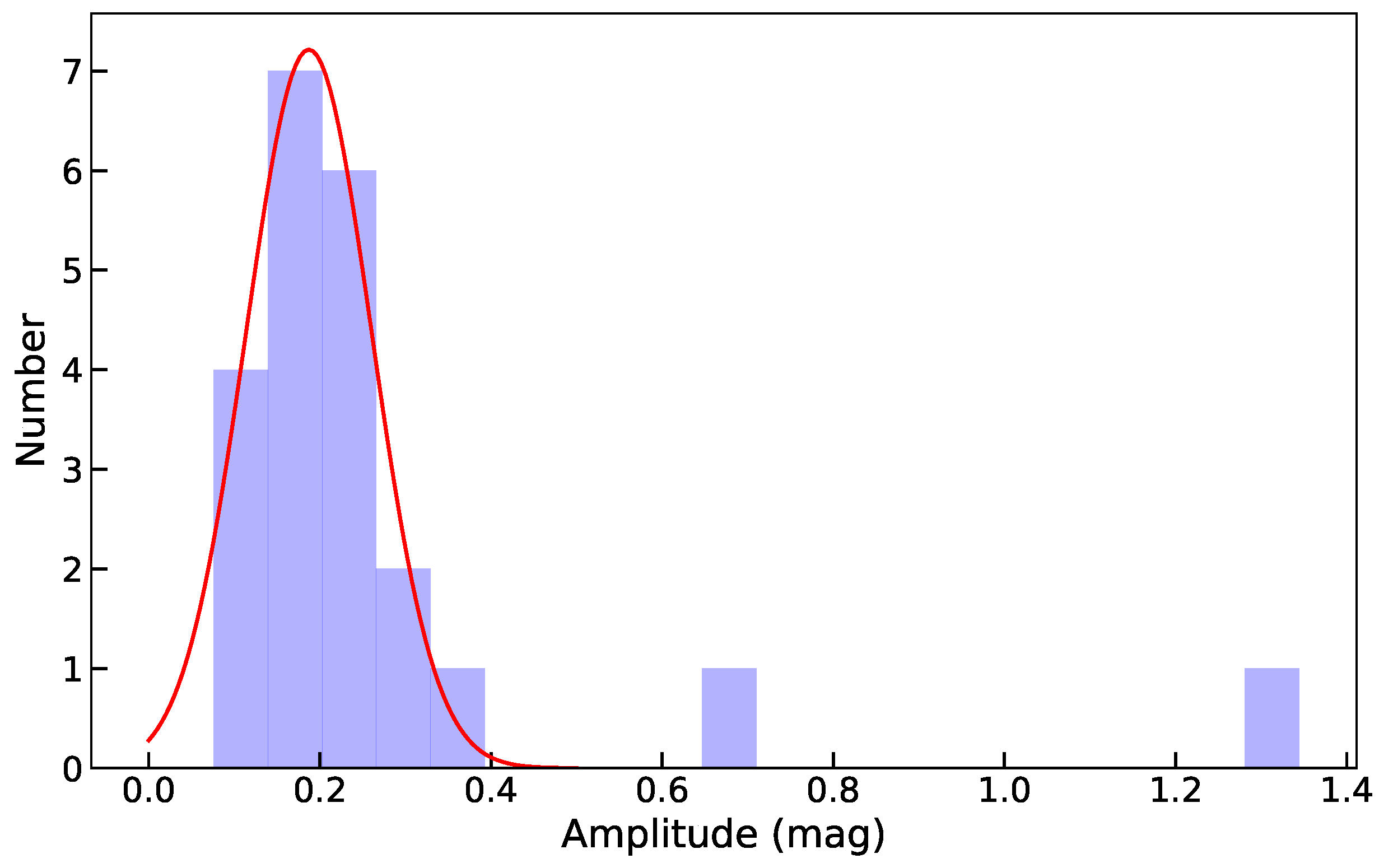

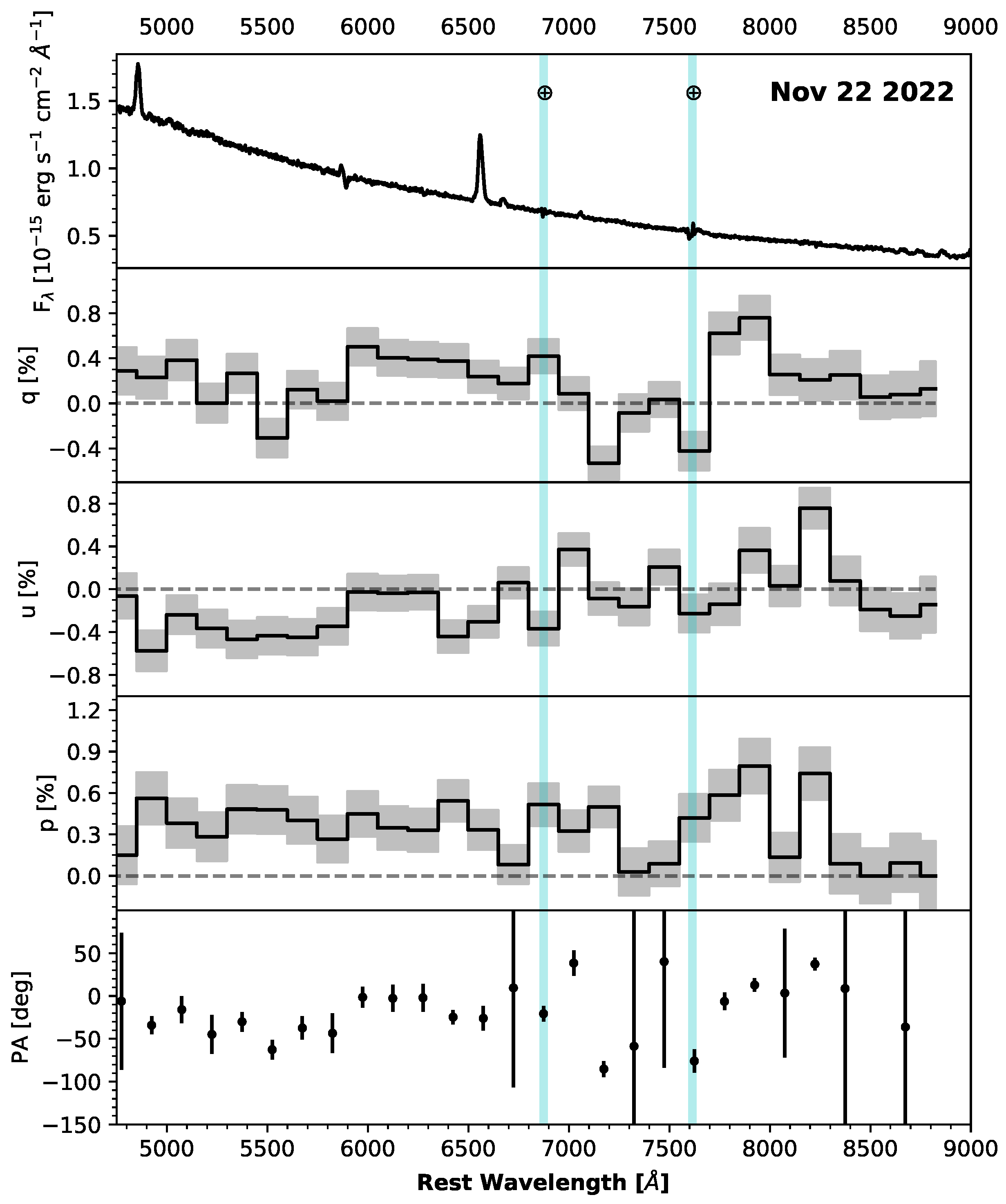


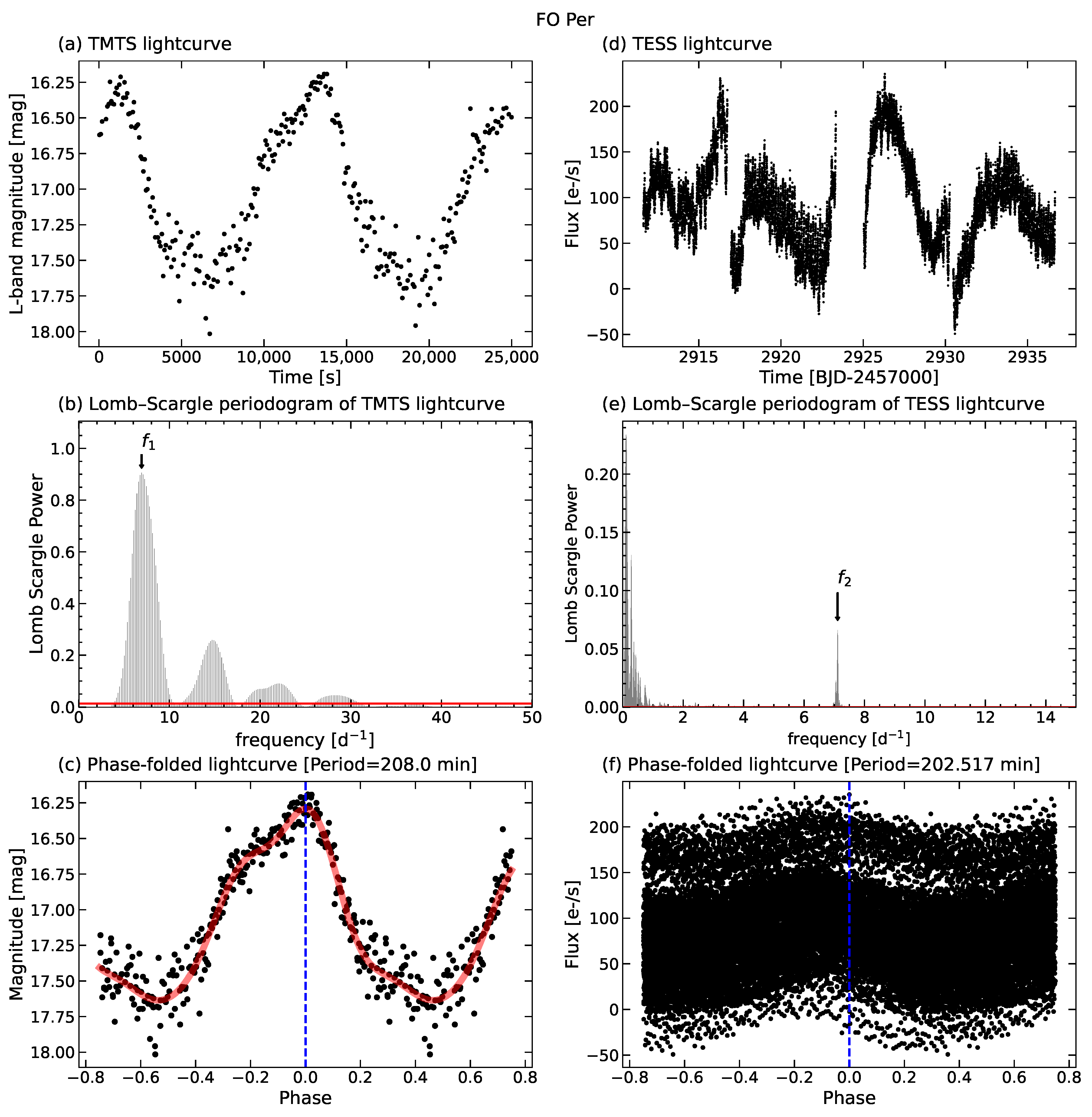
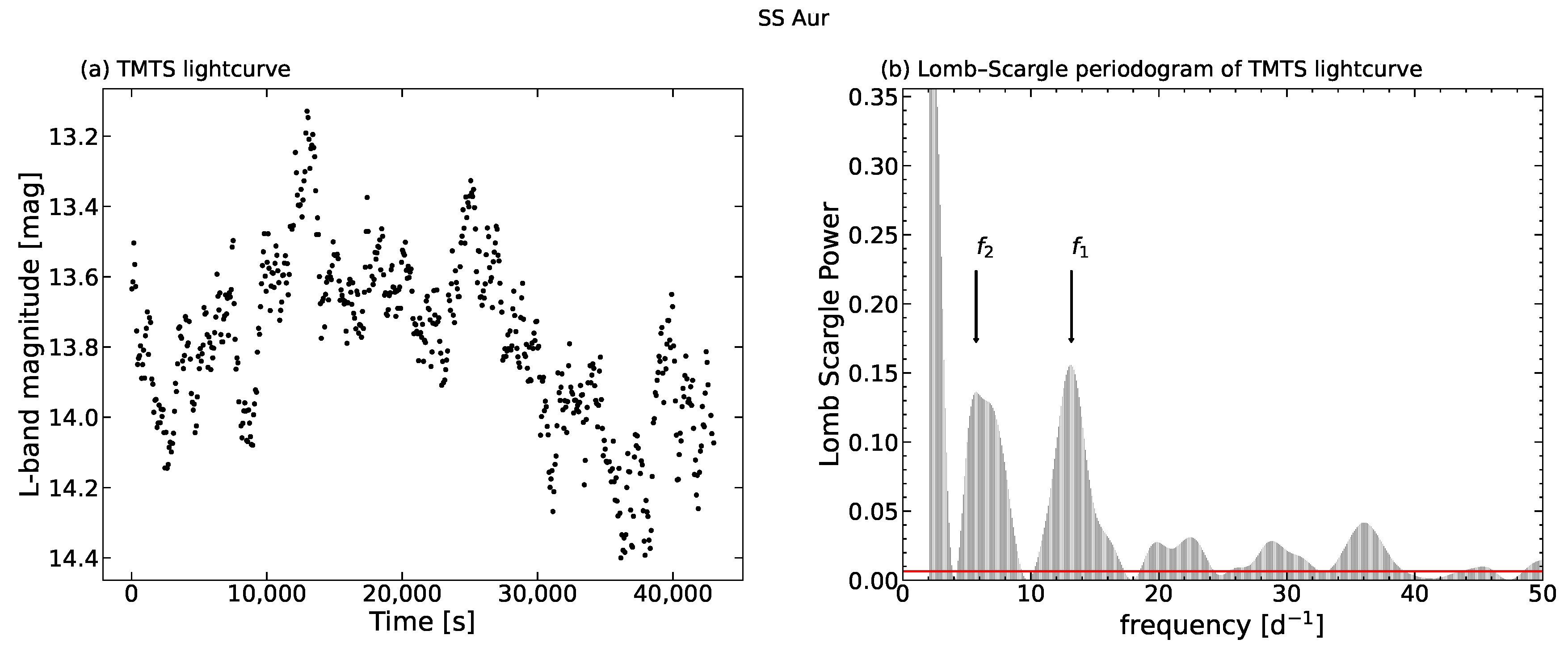


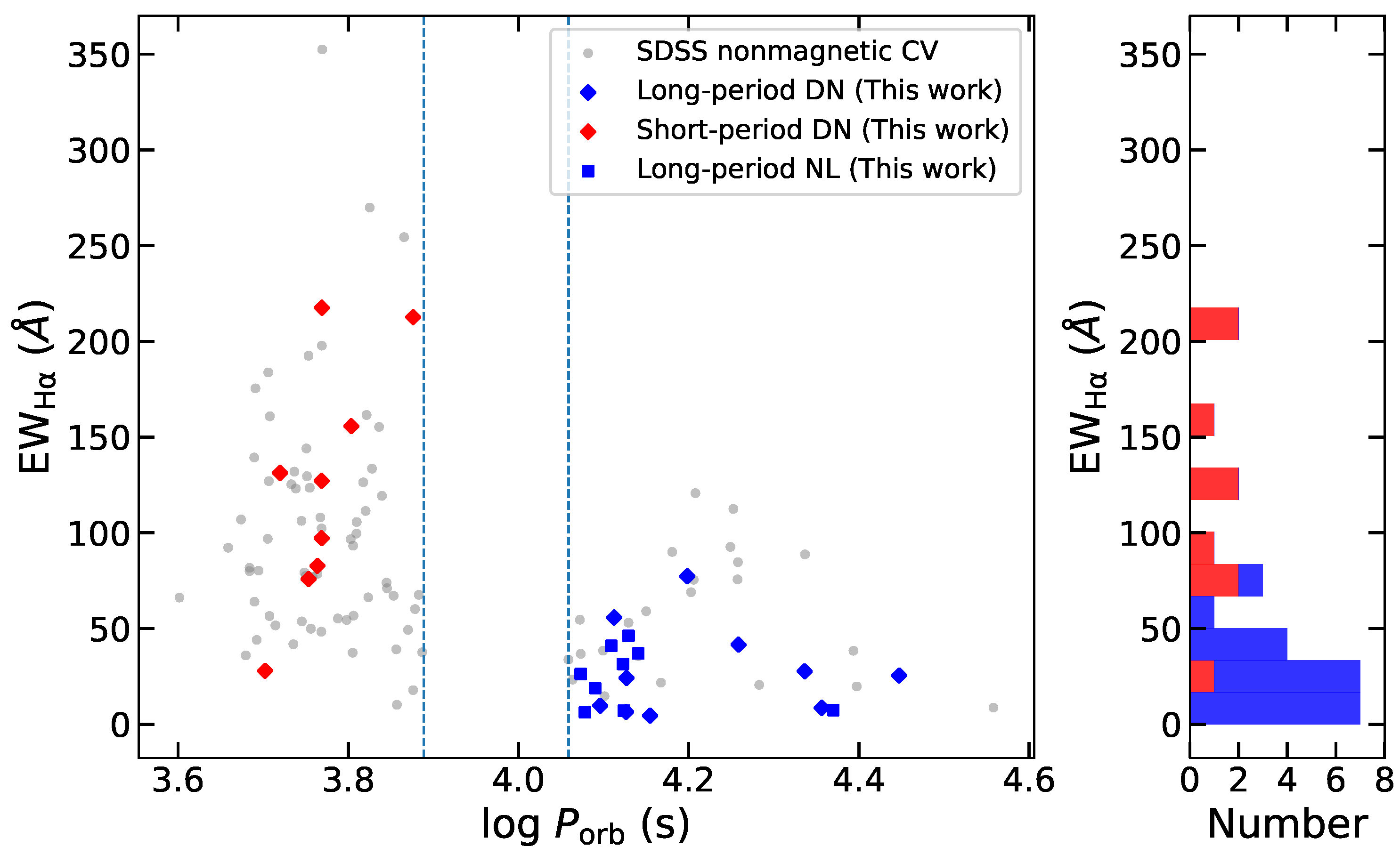
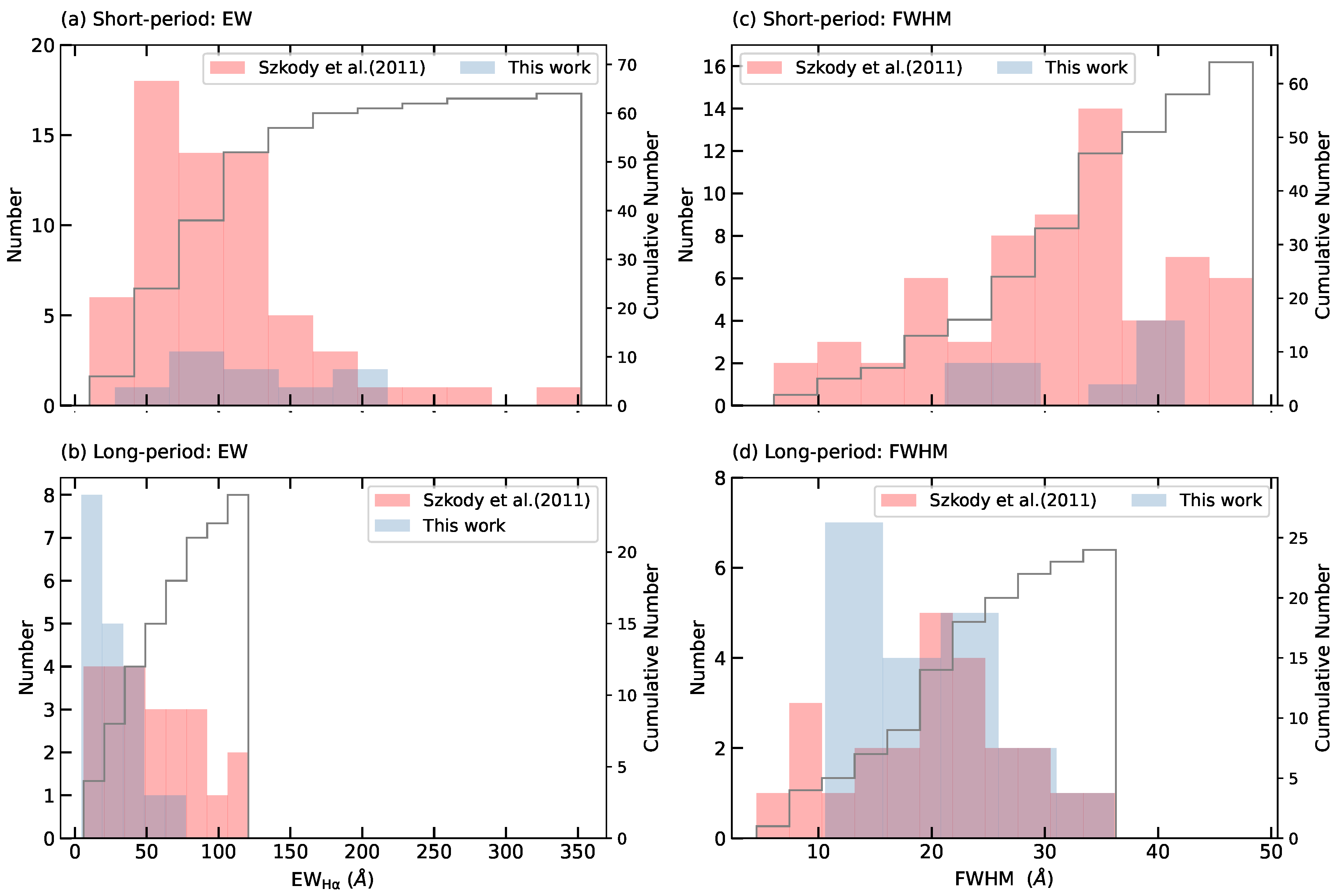

| Name | Start Time (MJD) | (min) | Amplitude (mag) | Feature | VSX Name | Reference |
|---|---|---|---|---|---|---|
| Dwarf novae | ||||||
| TMTS J00060995+5558501 | 59886.42805 | FI Cas | 1 | |||
| TMTS J01010887+4323259 | IW And | 1 | ||||
| TMTS J01043552+4117576 | L,R | RX And | 1 | |||
| TMTS J01101317+6004349 | HT Cas | 1 | ||||
| TMTS J01153217+3737354 | FO And | 1 | ||||
| TMTS J01275052+3808122 | 1RXS J0127+38 | 1 | ||||
| TMTS J02135093+5822527 | TZ Per | 1 | ||||
| TMTS J02262311+7118314 | AM Cas | 1 | ||||
| TMTS J02500008+3739219 | PY Per | 1 | ||||
| TMTS J03124571+3042477 | CRTS J0312+30 | 2 | ||||
| TMTS J03321548+5847219 * | AF Cam | 1 | ||||
| - | - | - | ||||
| TMTS J04023898+4250447 * | V1024 Per | 3 | ||||
| - | - | - | ||||
| TMTS J04083502+5114484 | H | FO Per | 1 | |||
| TMTS J04184443+5107313 * | NS Per | 1 | ||||
| - | L | - | - | |||
| TMTS J04260927+3541442 | MASTER OT J0426+35 | 4 | ||||
| TMTS J04463363+4857559 | ASASSN-15rs | 5 | ||||
| TMTS J05235177+0100303 | L | BI Ori | 1 | |||
| TMTS J05581781+6753456 | L | LU Cam | 1 | |||
| TMTS J06132238+4744248 | SS Aur | 1 | ||||
| TMTS J07485955+3125121 | E | SDSS J0748+31 | 5 | |||
| TMTS J08442711+1252322 * | E | AC Cnc | 1 | |||
| - | E | - | 1 | |||
| TMTS J08534425+5748402 | BZ UMa | 1 | ||||
| TMTS J09121621+5053531 | L | DI UMa | 1 | |||
| TMTS J10020745+3351005 | R | RU LMi | 1 | |||
| TMTS J10043481+6629148 | L | LN UMa | 1 | |||
| TMTS J10202651+5304330 | KS UMa | 1 | ||||
| TMTS J10543054+3006090 | SX LMi | 1 | ||||
| TMTS J10565691+4941183 | L | CY UMa | 1 | |||
| TMTS J12393204+2108063 | E | IR Com | 1 | |||
| Intermediate polars | ||||||
| TMTS J00225764+6141076 | R,L | V1033 Cas | 1 | |||
| TMTS J00284893+5917207 | V709 Cas | 1 | ||||
| TMTS J00551974+4612566 * | V515 And | 6 | ||||
| - | L | - | - | |||
| TMTS J03311195+4354154 | GK Per | 1 | ||||
| TMTS J05474838+2835104 | FS Aur | 1 | ||||
| TMTS J06251631+7334386 | R,L | MU Cam | 1 | |||
| TMTS J06274641+0148100 | E | V902 Mon | 7 | |||
| TMTS J07511729+1444239 | PQ Gem | 1 | ||||
| TMTS J08382201+4838023 | EI UMa | 1 | ||||
| TMTS J21334362+5107248 | 1RXS J2133+51 | 1 | ||||
| TMTS J22165027+4646412 | E | HBHA 4705-03 | 8 | |||
| Nova-like variables | ||||||
| TMTS J01385585+2429393 | SDSS J0138+24 | 9 | ||||
| TMTS J05064797+8319233 | E | V1024 Cep | 1 | |||
| TMTS J05572400+7241528 | L | LS Cam | 1 | |||
| TMTS J06293373+7104361 | BZ Cam | 1 | ||||
| TMTS J07565314+0858318 | E | SDSS J0756+08 | 10 | |||
| TMTS J08021533+4010463 | L | SDSS J0802+40 | 1 | |||
| TMTS J08125687+1911572 | E | NS Cnc | 1 | |||
| TMTS J08223605+5105242 | E | BH Lyn | 1 | |||
| TMTS J09030895+4117467 | BP Lyn | 1 | ||||
| TMTS J09201115+3356421 | L | BK Lyn | 1 | |||
| TMTS J10481806+5218295 | L | LY UMa | 1 | |||
| TMTS J23400423+3017476 | L | V378 Peg | 1 | |||
| Polars | ||||||
| TMTS J00185684+3454451 | V479 And | 1 | ||||
| TMTS J05154141+0104402 | E | V1309 Ori | 1 | |||
| TMTS J07112595+4404048 | E | V808 Aur | 11 | |||
| TMTS J11042565+4503131 | E | AN UMa | 1 | |||
| TMTS J13075377+5351303 | H | EV UMa | 1 | |||
| Candidates | ||||||
| TMTS J02461608+6217029 | L | V495 Cas | new | |||
| TMTS J03394099+4148057 | L | None | 9 | |||
| TMTS J03471387+1611083 | L | MLS_J0347+16 | new | |||
| TMTS J04405040+6820355 | L | None | new | |||
| TMTS J06183036+5105550 | L | None | 12 | |||
| TMTS J07200739+4516113 | H | MASTER OT J0720+45 | 13 | |||
| TMTS J09011350+1447046 | L | SDSS J0901+14 | 14 | |||
| Class | ||||
|---|---|---|---|---|
| (Å) | (Å) | (Å) | (Å) | |
| Short-period (Szkody et al. [40]) | 101.19 | 60.86 | 30.96 | 10.16 |
| Long-period (Szkody et al. [40]) | 53.07 | 32.70 | 19.90 | 8.07 |
| Short-period (this work) | 125.33 | 59.30 | 33.55 | 7.26 |
| Long-period (this work) | 26.47 | 19.33 | 19.47 | 6.96 |
Disclaimer/Publisher’s Note: The statements, opinions and data contained in all publications are solely those of the individual author(s) and contributor(s) and not of MDPI and/or the editor(s). MDPI and/or the editor(s) disclaim responsibility for any injury to people or property resulting from any ideas, methods, instructions or products referred to in the content. |
© 2024 by the authors. Licensee MDPI, Basel, Switzerland. This article is an open access article distributed under the terms and conditions of the Creative Commons Attribution (CC BY) license (https://creativecommons.org/licenses/by/4.0/).
Share and Cite
Liu, Q.; Lin, J.; Wang, X.; Dai, Z.; Sun, Y.; Xi, G.; Mo, J.; Liu, J.; Yan, S.; Filippenko, A.V.; et al. Minute-Cadence Observations of the LAMOST Fields with the TMTS: IV—Catalog of Cataclysmic Variables from the First 3-yr Survey. Universe 2024, 10, 337. https://doi.org/10.3390/universe10090337
Liu Q, Lin J, Wang X, Dai Z, Sun Y, Xi G, Mo J, Liu J, Yan S, Filippenko AV, et al. Minute-Cadence Observations of the LAMOST Fields with the TMTS: IV—Catalog of Cataclysmic Variables from the First 3-yr Survey. Universe. 2024; 10(9):337. https://doi.org/10.3390/universe10090337
Chicago/Turabian StyleLiu, Qichun, Jie Lin, Xiaofeng Wang, Zhibin Dai, Yongkang Sun, Gaobo Xi, Jun Mo, Jialian Liu, Shengyu Yan, Alexei V. Filippenko, and et al. 2024. "Minute-Cadence Observations of the LAMOST Fields with the TMTS: IV—Catalog of Cataclysmic Variables from the First 3-yr Survey" Universe 10, no. 9: 337. https://doi.org/10.3390/universe10090337
APA StyleLiu, Q., Lin, J., Wang, X., Dai, Z., Sun, Y., Xi, G., Mo, J., Liu, J., Yan, S., Filippenko, A. V., Brink, T. G., Yang, Y., Patra, K. C., Cai, Y., Chen, Z., Chen, L., Guo, F., Jiang, X., Li, G., ... Zhang, J. (2024). Minute-Cadence Observations of the LAMOST Fields with the TMTS: IV—Catalog of Cataclysmic Variables from the First 3-yr Survey. Universe, 10(9), 337. https://doi.org/10.3390/universe10090337






